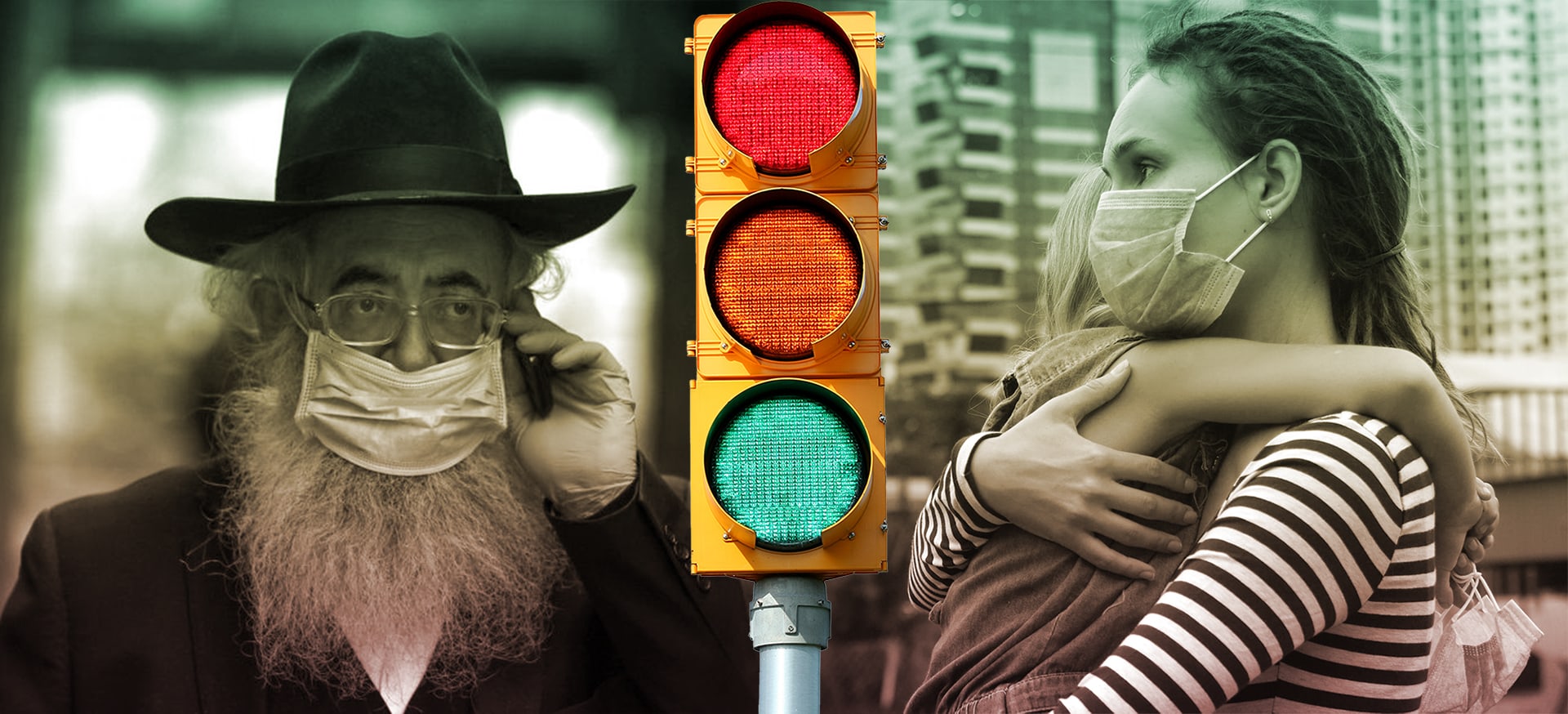The current system may be stuck due to insufficient data and an incomplete set of parameters used in calculating the score.
Like many countries, Israel has adopted a differential model similar to the EU’s “traffic light” system to monitor COVID-19, using color-coded zones based on risk levels. The model relies on a mathematical formula involving different variables to ultimately advise the appropriate level of restrictive measures, which is crucial for travel and keeping cities “open”. Under this model, a high score will trigger major limitations or even a lockdown to the relevant city, while a low score will enable an easing of restrictions.
Our research and experience with flattening the curve in Israel, has led us to re-examine the relevance of the variables in the traffic light model’s formula. As explained further in this article, we’ve so far concluded that the formula currently applied in Israel is flawed, as it does not consider some critical parameters which could help us measure the risk and morbidity in cities/towns with greater accuracy. We propose new parameters which, we believe, will help optimize the formula to better reflect the level of virus prevalence in Israel and ultimately aid in the management of the COVID-19 crisis.
“Local governments could finally act with greater precision, safely increasing measures where it is needed all while easing municipalities who currently find it difficult to trust the scores they are receiving — along with its dramatic consequences.”
How is Israel calculating the Traffic Light score?
To understand the problem and the potential solution for Israel’s differential model, we must examine the formula we have been using so far. The current formula — rating cities and towns as green, yellow or red — is based on three parts.
The first part, which reflects on the daily number of new positive cases and the rate of change, is composed of 2 parameters:
N — is the number of new cases in a city/town per 10,000 people within a 7-day period.
G — is the number of new cases in a city/town within a 7-day period compared to the previous 7-day period. Parameter G reflects the growth rate in a given area and can be referred to as “the multiplier rate”.
We notice that the dependence between parameters N and G is clear because it reflects how a pandemic naturally works: The number of positive cases one day affects the number of cases the following day, and the following week. In spite of that, we are still overlooking crucial information. This first part does not take into account the total number of active cases in a city/town. Because it only considers the newest cases, this formula lacks the crucial focus we should maintain on “old” cases. In addition, the infection rate is calculated in a way which cannot illustrate if there is a decrease.
The second part of the model’s current formula is based on the percentage of positive tests (P) in a given area. However, the data collected is exposed to various skewing factors. To start, the number of tests performed in a given area depends on the differences between sectors and cities, and therefore should be accounted for accordingly.
This second part also doesn’t consider pooled testing. Although the rates of positive testing should not include pooled tests — nor additional tests of recovered COVID-19 patients — they can help us calibrate how we read results to account for additional data distortion and manipulation. This would consider the reluctance to test among the younger population in an interest to avoid isolation, and the difficulty of obtaining referrals to get tested (sometimes even when a person has symptoms). Furthermore, we should not ignore initiatives in some cities aimed to increase the number of tested people in order to artificially reduce positive testing rates. As we can see, the second part of this formula is also clearly problematic.
This brings us to the third part of the formula: The addition of the constant K=2. There is simply no explanation as to why this variable has been added to the formula. Moreover, there’s no valid explanation as to why we are adding an absolute value rather than a relative value to a formula in which all the other parameters are relative and not absolute. Hence, all cities and towns currently receive a fixed factor, which is not proportional to the size of the locality or its infection rate. This goes to say that the formula does not differentiate between the various sectors and styles of living (including factors like population density), which are relevant to the dispersion of the virus.
Taking all of the above into account, we believe that the current formula — thus the current model — is not sufficient to forecast the differential behavior and events which characterize the spread of coronavirus.
Optimizing the system requires focus on these overlooked key factors
Analyzing what is wrong with the current system is only part of the challenge. How do we remedy it? We now know that the parameters we examine should behave in a differential manner to provide more accurate measurements for different sectors and styles of living.
To remedy the error as described above, the new parameters we propose should contain a time variable element, and be independent of the amount of testing and the percentage of positive tests. Here we introduce two new parameters which have not yet been considered:
1. Households: Households should become the central, pivotal factor in the new model. To help illustrate the importance of this factor, we can observe examples of COVID-19 dispersion in infection events. The conditions in live-in Yeshivah (religious educational centers) with dormitory facilities differ from those of a standard high school, leading to family members in the household and community members outside the household becoming infected.
It’s crucial to understand that the Household parameter is concerned with the dispersal properties of the virus, which breaks out in super-spreading clusters, largely in correlation with lifestyle and behavior — an approach we further explore through a critical comparison of variables R and K. This notion is also observed in our recent analysis of coronavirus spread circles in the Ultra-Orthodox communities, where we demonstrate that monitoring the Households is key to disrupting the spread of the virus, while enabling a semblance of normalcy and continuity of daily routines.
2. Number of severe cases: We suggest tracking the households which contain severely infected members. This approach is combined with a strong focus on factors such as age (particularly the more vulnerable demographic, 75 years and older), and the number of people in a household containing severely infected members. These factors can help us determine more precisely which areas/households present a risk of mass spreading, and how this spread would unfold based on where the severe infections are detected. For example, a scenario where we would find a dozen severe cases in one unique household is radically different from a scenario where we would find a dozen households each containing one severe case. The first scenario would be far easier to control than the second, therefore we would not apply the same restrictive measures even though the number of severe cases is the same.
In addition, another factor should account for the population density in neighborhoods — according to the number of people per meter — as it can help us estimate how rapidly the virus could spread outside of the infected household. In many ways, our attention is turning towards the dispersion characteristics of the virus and how the differences between cities/communities influence this dispersion. It is possible then, that a “sector-based” model will reflect more accurately the dispersion in the virus in different localities. The model can also include the number of tests and the number of positive cases if the pooled tests will be controlled as well.
By shifting our focus to these new differential parameters which hinge on the spreading characteristics of the virus, we can better assess different sectors and their lifestyles — which heavily influences the dispersion of COVID-19 — in the current Traffic Light model.
These parameters are also less likely to be manipulated (such as testing numbers), and can reveal a more accurate picture, ultimately influencing the most appropriate measures to apply in different localities. This could help prevent unnecessary lockdowns and increase public trust in decision makers. Local governments could finally act with greater precision, safely implementing restrictive measures where needed, and assisting municipalities who currently find it difficult to trust the scores they are receiving — along with its dramatic consequences imposed.


